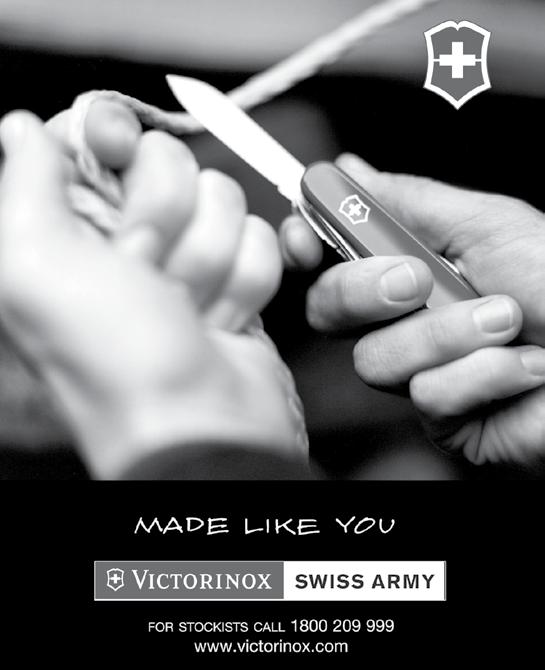A PRESIDENT’S PERSPECTIVE
The Second Instalment of the Final Tetralogy Bob Mouatt
T
he second instalment of my final tetralogy is about the media. My experience in working with the media dates back over 40 years when I wrote articles under a pseudonym for The Mirage (the RAAF Base Williamtown newspaper) and contributed items to The Newcastle Morning Herald on the RAAF Williamtown teams in the local Rugby competition. In the 1970s I edited a magazine for the Victorian Combined Services Rugby Club and contributed items to The Herald [Melbourne]. I changed sports in the late 1970s, and in the early 1980s wrote articles on Orienteering for The RAAF News. I have been contributing articles to The Canberra Times since 1986 and to the national media since 1997, so I consider I am well qualified to comment on working with the media.
Be Persistent and Consistent One of the best items of advice I ever heard was at a media workshop in 1987 when Gerry Collins (ABC Radio) stressed the importance of being persistent and consistent. The media strongly dislikes contributors who are not consistent in providing followup information, especially if space has been reserved for a story or results.
Timeliness The second key aspect in working with the media is timeliness. The media works to deadlines and if you want media coverage, you have to work to their deadlines. In seeking coverage in the national press, the key deadline is to get the information to AAP Sydney no later 6.00 pm AEST and preferably by 5.00 pm. This gives AAP time to process results and stories, and to distribute them to the national dailies before they finalise their pages. Achieving the AAP deadline is not easy given the time needed to confirm results and the distance that most major events are from fixed internet connections, but with the advent of wireless internet the task is a little easier. During the recent Australian 3Days I used a MiniMax [CDMA] modem to send the results for both AAP and the OA website from the event or on the road from the event. If you are an organiser always be mindful of the time pressures on the media liaison person to submit information to the media. I was especially grateful of the assistance provided by the SportIdent team during the recent carnival in South Australia. Television has much earlier deadlines, with most wanting to wrap up their stories by about 2.30 pm. While I have hired camera professionals to film major events on Betacam tapes [the main media used by TV networks] my experience is that regional TV stations will use reasonable high quality ‘grabs’ from ‘digicam’ cameras to complement stories as TV needs video to complete a story. Radio works to a much shorter timeframe and can take stories at short notice, but because of this news editors generally want immediate stories. If it is more than a few hours old they might not be interested. Extended interviews on general programs are different as they are often follow-up stories rather than ‘news’ stories.
The lead time for articles in major national magazines for other than regular columns is in the order of 3 to 4 months so a lot of forward planning is required. Approaches to such magazines usually need to be made about 5-6 months ahead of the target date for an article.
Format, Style and Expectations The third key element is providing material to the press in the format that it uses, and this can change from newspaper to newspaper. Each has its own format, as does AAP. It helps to get results and stories published if you provide your submission in the format used by AAP or the particular newspaper. Study the way the target newspaper presents the results and if it hasn’t published orienteering results, look at athletics results. For example, AAP does not include placings for the top three positions and generally publishes times in hours for times longer than 60 minutes. Also, it has specific ways of publishing State/ national abbreviations. Quite often people have unreasonable expectations of what the media might publish or broadcast. When I file stories with AAP or the press I usually provide three comprehensive sentences that cover what, when, why, who, how, etc. I provide all of my possible contact details as if they want more they will contact me, but if I provide too much they might not even look at the story. No more than 250 words is a good rule.
Evaluation As a systems analyst and designer by profession I have two key rules: • Always evaluate outcomes achieved • I t is a capital mistake to theorise without data [Sir Arthur Conan Doyle] If money is no concern evaluation is easy as there are media monitors who can provide a good service for a price; however, if cost is an issue other means have to be found. Orienteering Australia is fortunate that a librarian is able to use her work assets to provide a monthly review of information published by the press in electronic form. This is a highly useful source. My other key source is the Woden Public Library (ACT) which stocks copies of the major dailies. A few days after filing stories/ results with AAP I go through each of the papers at the Library checking for material published. This approach can be impeded if particular papers or pages are removed, as happened with copies of the Melbourne Herald Sun after Easter. Also no copies of The West Australian were available. My post-Easter 2007 evaluation revealed: • The Canberra Times – published results on 5 days out of 5 [includes The Sunday Times] • The Sydney Morning Herald – 4 of 4 [The Sunday Sun did not publish any results] • The Daily Telegraph – 2 of 4 [The Sunday Telegraph did not publish any results] JUNE 2007 THE AUSTRALIAN ORIENTEER 33


















